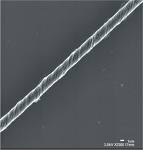Once upon a time, asbestos was considered a wonder material. Chemically inert and an impressive insulator, it was put to use in a variety of industrial and structural settings. Epidemiologists eventually traced an otherwise rare form of cancer back to lung exposure to asbestos particles, and building owners have been paying to have asbestos safely removed ever since. These days, nanomaterials are the objects of wonder, but, as early as 2006, some researchers were recognizing similarities in the properties of carbon nanofibers and asbestos. A paper published by Nature Nanotechnology suggests that the similarities go beyond appearances, as preliminary tests suggest carbon nanofibers pose the same health risks that asbestos does.
From a biological perspective, the fact that asbestos is chemically inert is actually part of the problem. The body can eventually absorb or encapsulate a wide variety of materials that wind up internalized, but there are simply no routes for cells to digest asbestos fibers. The alternate route, encapsulation, doesn't work well either. Asbestos fibers have a high length-to-width ratio (called an aspect ratio), which makes them hard for the body to deal with. They're small enough that single cells try to absorb them, but large enough that they fail, which triggers an indefinite inflammatory response in macrophages, the cells tasked with engulfing foreign material.
How this plays out in terms of asbestos isn't fully described, but appears to start with the small asbestos fibers traveling deep into the lung. Once there, it can actually be driven through cells and into the internal side of the lung, where it lodges into the mesothelial cells that line the organs and cavities of the trunk. Macrophages try to absorb any parts of the fiber that protrude, fail, and trigger an inflammatory response. This perpetual inflammation, combined with the cellular damage, helps drive the mesothelial cells into a cancerous state, producing the signature disease of asbestos exposure, mesothelioma.
Research has suggested that any fiber that's inert, small enough to make it to the lungs, and has a length-to-thickness ratio of seven or more could be capable of causing similar problems. That's where the concerns about nanofibers started. These fibers, which are commercially available, are often only tens of nanometers in diameter, but can extend for tens of microns. The chemical bonds among the carbon atoms that comprise them are also biochemically inert.
A number of studies have looked at the effect of carbon nanofibers on cultured cells, but the authors of the new paper took the studies into a more directly relevant model: the mouse. They injected carbon nanofibers, along with tangled carbon nanotubes and graphite powder, into the peritoneal cavity of mice; asbestos was also injected as a control. At two time intervals later, they washed the cavity out with saline and sampled the cells present in the wash. Two samples of untangled nanofibers produced an inflammatory response that was statistically indistinguishable from that triggered by asbestos.

When examined at the cellular level, tangled nanofibers were safely ingested and stored in macrophages. In contrast, the fibers caused what the authors termed "frustrated phagocytosis," where the macrophage appears as if it had been pierced by the fiber while trying to engulf it. Sections of the peritoneal cavity wall of these animals reveal the presence of large numbers of immune cells.
The authors caution that these results are not yet conclusive, as we lack two additional bits of data. This work hasn't demonstrated that the nanofibers actually reach the lung or cross into the body side of the organ when ingested via breathing. On the other end of the process, the researchers haven't demonstrated that this inflammation ultimately produces mesothelioma. It does, however, suggest that studies directed towards finding out should be pursued as soon as possible and that, in the meantime, a cautious approach to nanofiber exposure may be warranted.
Nature Nanotechnology, 2008. DOI: 10.1038/nnano.2008.111
reader comments